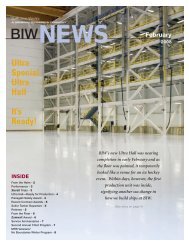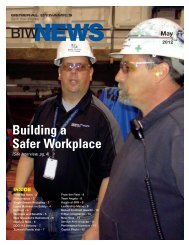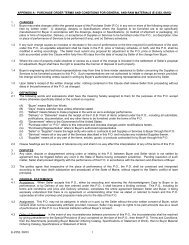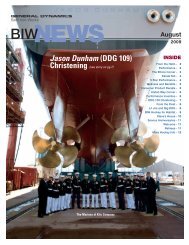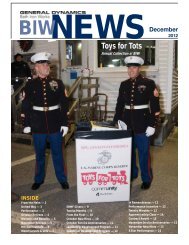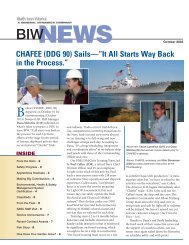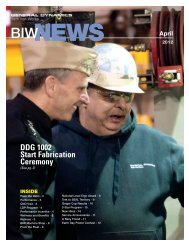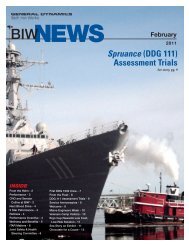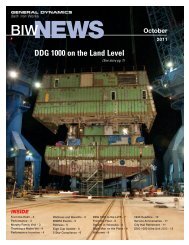Build It and They Will ComeAfull scale replica of the Zumwalt(DDG 1000) Integrated Bridgecurrently resides in the loft atHardings where it continues to playan important role in the design ofDDG 1000. Visitors from the Navyand the DDG 1000 Team have used themock-up to assess the human factorsof various design solutions against afull size representation of the bridge,including the alcoves.The Integrated Bridge is the largestof five mock-ups created by BIW’sHuman Systems Integration (HSI)Team for DDG 1000 purposes. Thisone was constructed and erected at theHuman Performance Lab (HPL) at theNaval Surface Warfare Center inDahlgren, Virginia. Cameron Shuck(D40) was assigned to lead the designand construction of a sturdy, full scale,high fidelity replica of the Zumwaltbridge, including an accurate representationof every physical aspect of thebridge and the means to assess thephysical aspects of the crew’s interaction.Using guidance drawings,Cameron and Mark Bodmer (D40)created a highly accurate replicathat could also be disassembled andrelocated, if desired.Ken Crowe (D40), BIW HSIDeputy, said, “The Zumwalt bridgeis the first destroyer bridge withoutwings in the Navy’s surface fleet whichpresents a challenge in terms of the waysailors and officers are used to obtainingvisual and even audio information.The Navy wants to know that thebridge will function as planned and theHSI Team was the logical group toinvestigate.” He continued, “At thisstage, we are not looking to makechanges, but at the same time, if thereare any ‘system-won’t-work’ kinds ofissues, we want to know before thebridge is fully built so we can findsolutions within the current crew size.”The mock-up includes consoles,seats and terminals and allows the HSITeam to evaluate the space available foreach function, the ease with which theoperator can perform the function andthe details of what the operator can seeUsability Testing inside the DDG 1000 Integrated Bridge Mock-up with assistance from officers andcrew members of Jason Dunham (DDG 109).and hear. While at the HPL, the team conductedformal Usability Assessments withexperienced fleet sailor Subject MatterExperts (SME’s), internal design reviewswith senior team leadership and stakeholder/sponsorreviews and assessments.When work was complete at Dahlgren,the mock-up was disassembled, labeled andshipped to Maine where it was reassembledin the space at Hardings that once housedthe WWII-era Mold Loft. Cameron wasagain tasked to improve the fidelity andutility of the mock-up. Once at Hardings,the model’s pieces and parts were turnedover to Rodney Douglass (D20) who creditsMarc Allen and Dave Brown (both D20) forthe reassembly. Since then, it has enjoyed afield of dreams existence where people fromacross the team have come to assess specificdesign decisions against a 3-dimensionalversion of the actual bridge.John Hagan (D98), BIW’s HSI Director,relayed that Dr. Jim Pharmer,NavyUsability Test Lead, praised the repeateduse of the Bridge Mock Up as the mostefficient and effective usability test of itskind that he had participated in, andcomplimented Cameron’s accuracy andattention to detail, as well as the team’sability to maintain the mock-up consistentwith the progress of detail design.Cameron served as Test Director for a3-day usability test conducted in Decemberto resolve the remaining crew design uncertaintiesassociated with the bridge design.Officers and sailors from the Jason Dunham(DDG 109) precommissoning crew acceptedJohn Hagan’s invitation to serve asSME’s. A total of 8 officers and sailorsparticipated, including the PCO, CDRScott Sciretta, several department headsand several highly-experienced Chief PettyOfficers. A crew and operator run-throughwas led by Dave Rollins, an HSI consultantwith a strong Navy and shipbuilding background,whose contributions allowed HSIto present detailed and realistic scenariosover multiple events. The test was conductedfrom the starting point that “giventoday’s design, are there issues or missingitems that can be solved now?”A lively exchange ensued as the SME’sconducted work evolutions which largelyconfirmed full functionality. The reportwas fully reviewed and assessed by the Navyand DDG 1000 design agents and resultedin a finding of no major problems.Representatives from the Navy’sOperational Test and Evaluation Command(OPTEVFOR) stated that they continue tobe very pleased with the findings ofUsability Testing in the context of highly6 | January 2010 | BIW NEWS
detailed mock-ups. Future potential useincludes precomm crew training, shorebasedbridge trainer design decisions andfinal verification of the crew design.One other HSI mock-up, the HeloControl Station (HCS) was also movedfrom Dahlgren to Hardings and is collocatedwith the bridge. The HCS has beenextensively used by Navy Aviation certificationand HCS hardware vendors to assessand refine the design. OPTEVFOR representativescommented that use by AviationCertification representatives so early in theprocess was very productive.T.J. Champion (D40), who led thedesign and construction of this module,reported that “Usability testing of the HCSrevealed things that both should be fixedand could be fixed due to the stage ofdesign. For instance, the operator’s view ofthe flight deck was not as good as it couldbe. By rethinking the layout of a few keycomponents, we were able to optimize theoperator’s ability to perform his job.”L to r: T.J. Champion, Cameron Shuck and Vince Quintana in the Bridge Mock-up facility at Hardings.Vince Quintana (D40), HSI DesignVerification Lead, said, “Through usabilitytesting using these full scale models, wehave proven that the planned manning iscorrect in many spaces. However, testinghas also shown that manning had to beincreased in certain spaces while manningcould be reduced in others. The result ofthis work is increased confidence in theship’s design.”A Better ApproachIn the past, welders on the Panel Line have faced a difficulttask when welding plates together. Where the metal isthick, it has to be gouged out on the back side whichrequires a mechanic to lay on his or her side to perform thetask, repositioning every 6- to 12-inches along a seam thatcan be 50-feet long. It’s a time consuming, dirty job for themechanic and imperfections from the hand gouging processincrease the likelihood of weld defects.Brian Fraser (D43) observed the advancements availablewith automated welding technology and on his own, beganto research the availability of an automated gouging tool.He presented his findings to Mike LeMay and Justin Clark(both D10) who liked what they saw and in turn, broughtin Ryan McNulty (D10), a manufacturing engineer, toinvestigate further.Further research resulted in a vendor equipment test inthe welding lab, which Brian witnessed. The test indicatedgood results and a much reduced process time.Justin Clark said, “The old method was difficult from anergonomic point of view. The automated equipment doesaway with the mechanic having to maneuver that long,slow slide across the floor and it also eliminates a lot of thevibration from the hand grinding and the need to be soclose to the process. This is much better and it came aboutthrough Brian’s initiative.”Dean Brown fromthe welding lab andBrian Fraser duringtraining exercises inthe Aluminum Shop.BIW NEWS | January 2010 | 7Ultra 3000 leaving the building.



